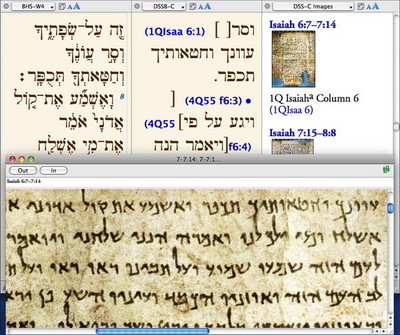Before Accordance 1.0 was first released way back in 1994, we began working with a leading Qumran scholar who was interested in developing a grammatically-tagged text of the Dead Sea Scrolls. In fact, we helped demonstrate an early prototype of that text at the SBL meeting of 1994. The tagged Qumran sectarian manuscripts were finally released for sale in 1999, and Accordance immediately became an indispensable tool for many Qumran scholars.
Not long after that, work began on tagging the various Biblical scrolls found at Qumran. Since this material had two referencing systems (the Biblical reference as well as the Qumran scroll reference), we had to solve new problems related to presenting the scrolls in electronic form. We released the Dead Sea Scrolls Biblical Manuscripts at SBL in 2007.
At this year’s SBL, we extended our lead in Scrolls research even further with the release of several new modules. The Dead Sea Scrolls Greek Bible represents the entire Greek corpus of biblical scrolls found in the Judean Desert between 1947 and today. The Judean Desert Corpus contains the non-biblical, non-Qumran texts found in the Judean Desert region since 1947. This is a growing corpus that will be expanded in future updates.
In addition to these new tagged texts, we are very pleased to announce the release of our new DSS Images modules. These modules contain spectacular high-resolution images of the first scrolls ever photographed. As is well known, the first of the Dead Sea Scrolls were discovered by Bedouins in 1947. They sold these scrolls to an antiquities dealer who in turn sold some of them to a private collector. While they were in his possession, the collector allowed scholars at the American School of Oriental Research to examine and photograph them. John Trever was the scholar and photographer who took these first photos, and his son James Trever has scanned and enhanced these images for maximum usability in Qumran research.
The DSS Images module is arranged in Qumran manuscript order and contains both sectarian manuscripts such as the Rule of the Community (1QS) and biblical manuscripts such as the larger Isaiah scroll (1QIsaa). The DSS-C Images module contains the Biblical scrolls arranged in canonical order. It also includes the Pesher (a kind of commentary) on Habakkuk (1QpHab). As reference tools, you can view them in parallel panes with the text of Bible or the Qumran manuscripts. You can also view the images as separate windows and compare the transcribed texts with the images of the scrolls themselves. And of course, these images are excellent visual aids when teaching about the scrolls.
With these new releases unveiled at SBL, Accordance has once again extended its lead in Dead Sea Scrolls Research.


